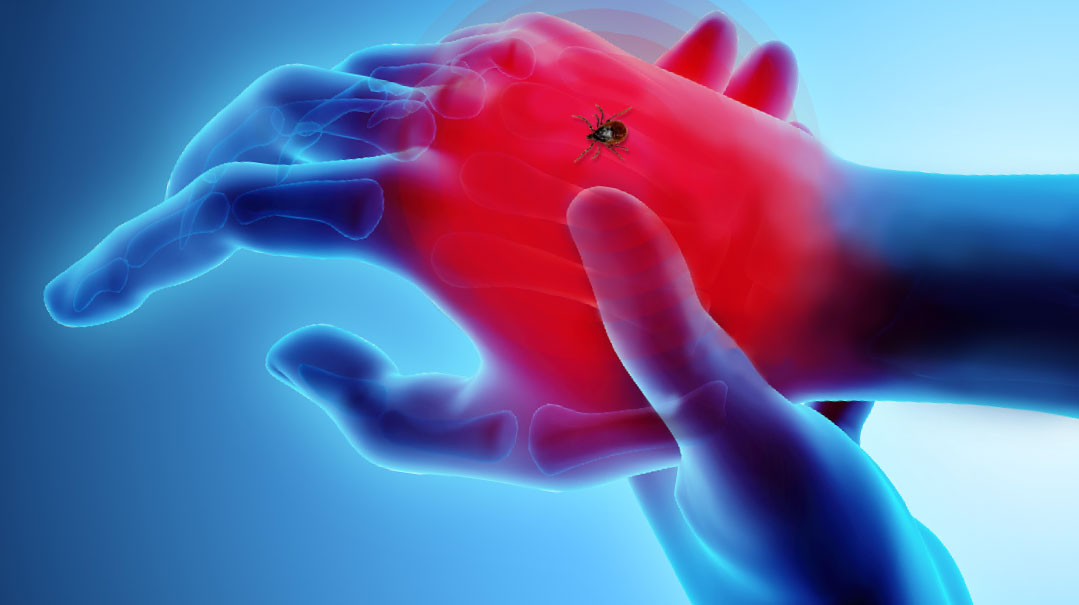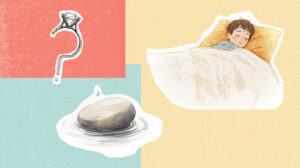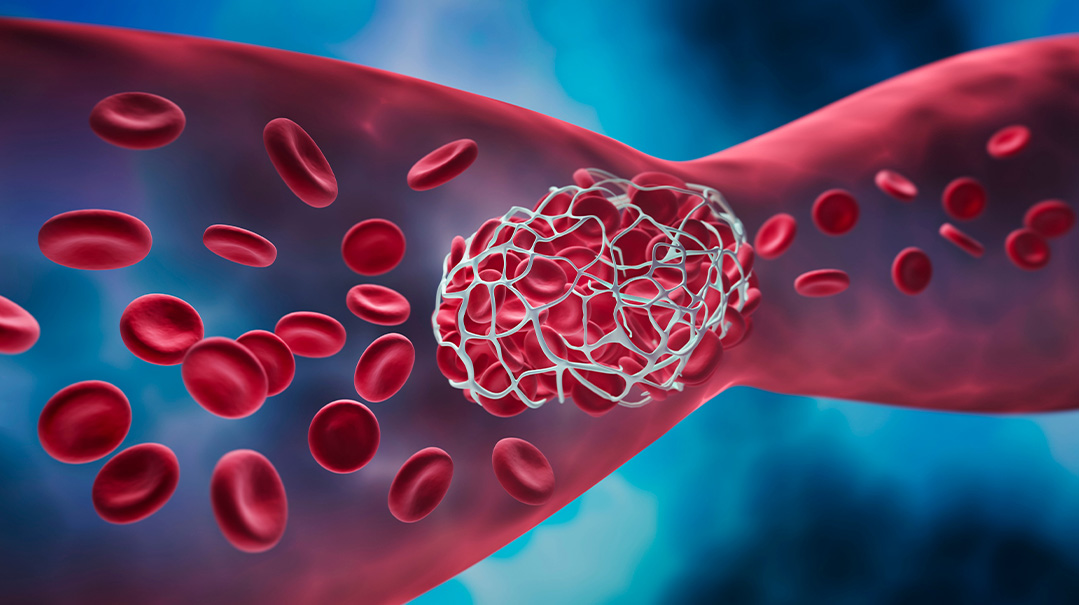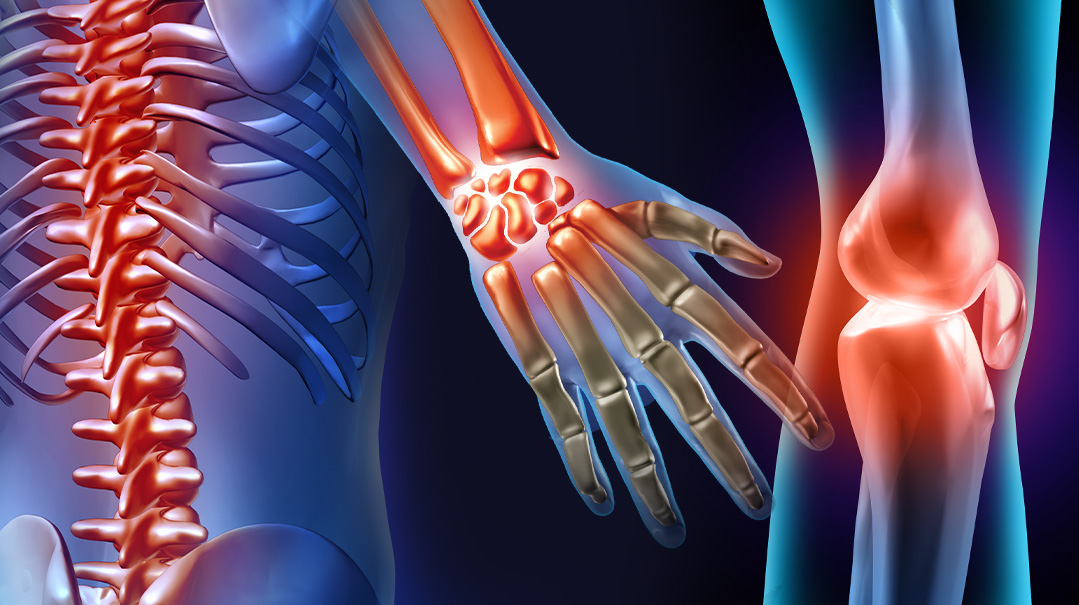A Single Bite

Their world was about to be upended; and the catalyst would be a tiny bug, not much larger than a poppy seed

"Yoni was sunshine and joy from the moment he was born, straight through eighth grade. For 14 years he was an absolute pleasure in every way.”
That’s how Chani Klingstein begins her harrowing tale; a singular story that’s part of a larger, ever growing narrative. Dotting all 50 states, coast to coast, are thousands of stories like Yoni’s — and the numbers keep rising every year.
“The fact that Yoni was so easy and happy for his entire childhood and into his teenage years, created a huge missing piece for us while we were struggling for answers. He shined socially, academically, in his middos; one veteran rebbi at his school told me that he’d never had a student like Yoni in all his years of teaching.
“Yoni had this infectious smile, people couldn’t get enough of him. He was also blessed with a sharp mind, and a passion for learning and academics. By the end of eight grade, he was at the top of his class and what we saw in front of us was a flaming bright future.”
The Klingsteins had no idea their world was about to be upended; and the catalyst would be a tiny bug, not much larger than a poppy seed.
“We live in a small, out-of-town community, so transferring to high school was no real adjustment, Yoni knew the boys in his class, and had a solid support system and great social standing. We didn’t anticipate any issues, and for a few months everything was fine. Then one day Yoni started to complain that he didn’t feel ‘himself.’
“He wasn’t a complainer so the fact that he mentioned something was concerning. Then he started to lose focus in school, he couldn’t concentrate, he seemed out of it. We tried to brainstorm — maybe the school wasn’t the right fit? We decided to switch him to another school a bit further away, one that was renowned for their high level of learning and really pushed the boys to give it their all.
“Many friends raved about the yeshivah and we thought Yoni might thrive in a more competitive setting, but unfortunately that wasn’t the case. He started losing weight and stopped sleeping well. As the months passed, we became more and more anxious; our bright, energetic son was becoming a shadow of himself. At times he’d pace the room in a strange way, back and forth, his face gaunt and pale. He became withdrawn, like he was living in a brain fog. It was clear the boy we knew and loved was drifting away.” Chani lets out a long sigh. “As a mother, I can’t even describe what it felt like to watch him grow weaker every day. It was excruciating.”
***
The situation may have been new and utterly distressing to the Klingsteins, but Yoni wasn’t the first teenager to display the same sudden onslaught of troubling symptoms, not by a long shot. A very similar scenario sent two mothers searching for answers in 1975. Residents of Lyme, Connecticut, both mothers had noticed a frightening pattern among their own children as well as many other children in the neighborhood. A disproportionate number of kids were complaining of knee pain, strange rashes, extreme chronic fatigue, and trouble focusing — then subsequently being diagnosed with rheumatoid arthritis.
When the mothers turned to nearby Yale University’s health department, begging them to research the high numbers, the prestigious university sent Dr. Allen Steere down to Lyme to start collecting data. What he found there was mind-boggling.
According to country wide statistics, it would have made sense for one or two children in the area to have rheumatoid arthritis. However, in the area of Lyme and the neighboring counties, there were 39 children and 12 adults suffering from the disorder. What made the situation even stranger was that there was clustering; on some roads there were large groups of children, all suffering from the same strange array of migraines, fatigue, and joint pain. Some had a distinct bulls eye rash.
Dr. Steere began to search for answers, just like the Klingsteins over 40 years later.
“Obviously, we started from the ground up,” Chani explains. “We went to pediatricians, then specialists, then therapists, and finally a top psychiatrist. All tried to be helpful, but no one could pinpoint anything specific. They said he was suffering from anxiety and we started him on medication. But we saw very little change; therapy didn’t seem to help either. We had a billion questions and no answers.
“For a few years we trekked from one therapist to the next while things got progressively worse. Yoni became more and more out of it, developing frightening symptoms of psychosis and becoming increasingly catatonic; we felt like we were at the end of the road.
“Over the years he seemed to have shed his personality; by the end of high school he was almost robotic in his movements and he rarely smiled. The warm and effusive boy who was always looking to learn something new, sit down with a challenging sefer, or put together a ball game had unraveled. I took on extra kabbalos, I begged Hashem with everything I had to send us answers.
At the end of 12th grade, things were worse than ever. The school arranged a week-long getaway for the boys, including a shabbaton at a large campsite a few hours away. Considering the state he was in, my husband and I were very worried about sending Yoni, but he desperately wanted to go. He wanted to be normal and do what everyone else was doing. At last we conceded, albeit reluctantly. We sent him, hoping for the best.”
It was a mistake.
“The night the menahel called us to come pick up our son was one of the hardest moments of my life. He apologized profusely, but it was clear that our Yoni was a liability. He wasn’t stable enough to be away from home. They couldn’t take achrayus.
“My heart bled that day; the world was so dark. Our dream of sending our son to learn in Eretz Yisrael or even just to attend one of the big in-town yeshivos was gone, his future was now so uncertain.
And in that black hole, I realized that this was it, this was the deepest part of the pit. I felt we’d reached the very bottom, and somehow this was the beginning of the yeshuah.
We brought Yoni home but things continued in the same vein for a while. He began having strange outbursts. He was pacing, twitching, and making odd movements. Physically, he was in front of me… but it felt like he wasn’t there.
Not long after that, a friend suggested that we go to a different doctor, one we hadn’t seen before. He was well known for looking at the whole picture, not just the individual symptoms. After hearing Yoni’s long history and speaking to him at length, he gave us a diagnosis which left us shell-shocked: He believed Yoni was suffering from Lyme Disease.”
“As soon as we got the diagnoses, I was literally speechless.” Chani says softly. “How could this be Lyme? I thought Lyme disease was all about swollen knees and a bullseye rash. Then my husband remembered an incident that occurred way back during the summer before Yoni entered ninth grade. The camp nurse called to say that Yoni had a tick embedded in his neck, but it wasn’t the kind that carried Lyme. In our ignorance, we thought nothing more of it.
Suddenly things began to fall into place. We felt that we’d reached emes and now we beseeched Hashem for continued siyata d’Shmaya to combat this enemy. We took Yoni for the most advanced blood tests available to check for Lyme disease and sure enough — there it was.”
***
By 1976, Dr. Steere and his team put forth the idea that the strange symptoms plaguing the residents of Lyme, Connecticut were due to a tick-borne illness. The idea was based partially on reports from Europe where evidence showed that tick bites could cause rashes and a host of other symptoms.
While the area of Lyme had been mostly farmland during the first half of the century, large portions of land had been converted back to forests in the ’60’s, which brought an abundance of wildlife to the area. By 1976, Lyme was home to a plethora of deer, ticks, and a mystifyingly complex disease that we’re still battling today.
In 1981, a researcher named Willy Burgdorfer identified the bacteria which causes Lyme disease — Borrelia burgdorferi — and since then, cases of Lyme disease have ballooned to astronomical proportions; some estimate the number is well over 300,000 new cases a year. While awareness has improved over time, Lyme has some devious qualities that make it hard to catch, hard to diagnose, and hard to treat.
Mrs. Esther Honig is the cofounder of Life for Lyme — a division of the Orthodox Jewish Chamber of Commerce Health and Medical Alliance Division.
The vast networking opportunities and connections provided by the OJC, as well as the founders unflappable dedication, has helped Life for Lyme become the veritable wellspring of information and support that it is today.
“Every person’s body reacts differently to Lyme disease.” Esther explains. “The reaction is based on their own personal immune system. Yes, there are some predominant symptoms that we see more often than others, but Lyme symptoms are often extremely individual, and obviously, that makes it that much harder to catch.”
That’s only the tip of the iceberg when it comes to the Lyme’s elusiveness. Many people, like Yoni, never recognized the necessity of taking antibiotics, and his symptoms only showed up months after the bite.
Furthermore, up to a quarter or more of Lyme disease patients never display the telltale bullseye rash and don’t even know they were bitten by a tick in the first place. Baby ticks fall off after biting, so those are often missed. And some people do everything right, go straight to the doctor, dutifully take their medication, but for unknown reasons, fail to respond to the antibiotics. Their symptoms persist for years, often debilitating them — infectious disease specialists call this Post-treatment Lyme Disease Syndrome.
Sometimes complications arise because of the coinfecting pathogens the patient was infected with at the time of the bite. Babesia, anaplasma, ehrlichia, or bartonella are some of the harmful bacteria a tick might carry and pass along with the bacteria that causes Lyme disease. Every tick had its own journey; therefore, every tick bite unleashes a different beast.
And finally, the Lyme tests we have today don’t test for the bacteria which causes the disease, rather for the antibodies the body produces when fighting Lyme. One can have the disease, and the antibodies can be sequestered or just not show up in the blood. Commonly, they show up after one treats with antibiotics — but antibiotics aren’t routinely prescribed unless the test comes out positive, resulting in the ultimate Catch-22.
One mother describes how it looked in their case. “My daughter took the ELISA Lyme test (generally the first test one takes to check for Lyme disease) which came back positive, but because she had three negative Western Blot tests (a second test, which confirms a positive ELISA test), the doctor told us her ELISA test was a false positive. Even so, we had a very strong suspicion she was battling Lyme.
“After she was treated with IV antibiotics, Western Blot tests number four and five were positive according to the CDC standards. We finally got insurance for the treatment.”
Menachem Reznick, cofounder of Life for Lyme, explains that testing for Lyme disease is complicated. “Across the board, everyone agrees that the current testing system for Lyme is outdated. But the world is waking up. Both Johns Hopkins University and Columbia are making strides toward creating a reliable test, congress recently approved funding for more research.
“However, these things take time. Until then, we’re left with a lot of missed or misdiagnosed cases. When the bacteria sits for long periods of time in the body, the body begins to recognize it as part of its original makeup instead of a foreign entity, and gives up on fighting it. In a case like that, the antibody test won’t show anything.”
Chani knows they were lucky. “The fact that the Lyme showed up in Yoni’s bloodwork made things a lot easier.”
But even though they had a diagnosis, the Klingsteins’ journey wasn’t over. “We started going to a doctor who treated Yoni with detox treatments and supplements, but our son wasn’t in the frame of mind to follow the heavy regimen and we had to stop.”
Menachem Reznick is well aware of the hurdles people face when starting treatment. “I always tell people that finding the right Lyme treatment can sometimes feel like going through the shidduch process. There are different approaches and some things might work for one person and not the other. There are those who want to try a more holistic approach, and I’ve seen some less severe cases resolved that way, but if that doesn’t work, then you have to move on to something else.”
Chani wasn’t about to give up so fast. “Life for Lyme recommended we see an incredible doctor who looked over Yoni’s case and helped us understand that the bacteria had sat so long in his body that a very specific regimen of strong antibiotics would be the most powerful and beneficial treatment option. The insurance company also recognized the severity of his case, and provided coverage for the treatment.”
***
Dr. Brian Fallon, a new York based psychiatrist and director of the Lyme and Tick-Borne Diseases Research Center at Columbia University, has stressed many times over the past 30 years that in areas of the United States where Lyme disease is endemic, medical practitioners must always consider the possibility when presented with a conundrum.
The implications of Dr. Fallon’s urging for the frum population, specifically those who reside or summer in the Northeast, are immense. Lakewood, Monsey, the Catskills, and the Poconos are all rife with Lyme. Unfortunately, too many stories like Yoni Klingstein’s are happening every year, and that’s why his mother is passionate about spreading his story.
“We’re well connected people. We spoke to the best doctors and it still took us five years to figure out the source of Yoni’s illness. I don’t want to see any other families go through what we went through. The suffering could be avoided with the right medical guidance and immediate antibiotics. People need to know that Lyme can present in a multitude of ways, not just with the typical symptoms. We need awareness.”
Mrs. Esther Honig is trying to do just that. “We have three branches within the organization.” Esther explains. “A referral department, a support group, and a team that focuses on raising awareness.”
“On busy days we can get ten calls, ranging from straightforward cases to extremely complicated ones,” says Avrumi Safier, who experienced his own journey with Lyme disease. “Unfortunately, the answer to Lyme is not a simple ‘here take this pill’ and you’re cured. Lyme, and the coinfections that often come with it, can cause a huge array of symptoms — from simple ones like a cold to extreme ones, like full body paralysis and psychotic episodes. Each phone call takes time, we want to provide as much information and guidance as we possibly can.”
When Chani found her way to Life for Lyme, everything changed. “I was shocked by how many people in our insulated world had silently suffered from Lyme disease. The support we received through the organization has been unbelievable.”
The number of cases is equally unbelievable — but there’s hope.
“We’ve seen cases where Lyme sufferers had psychotic episodes and unfortunately needed to be put in psychiatric wards for their own safety. Baruch Hashem, after treating their Lyme disease, they are fully cured today,” says Safier.
Menachem Reznick explains that psychiatric symptoms of Lyme aren’t at the top of the symptoms list, but they do encounter them on a regular basis. “Tommy Hilfiger’s daughter spent six months in a psychiatric ward before doctor’s figured out what was wrong with her.
“The medical world has evolved in recent years. The thinking used to be that if someone was suffering from psychosis, then clearly there was a chemical imbalance in the brain, or emotions gone haywire, or trauma. Now, psychiatrists have broadened their view. That includes testing for many other things, like thyroid issues for example.
“We always urge people to cover all the bases — yes, psychiatric symptoms could indicate Lyme. They can also indicate many other things. Lyme mimics many other diseases. We never tell a caller, ‘yes, we think you have Lyme.’ Our job is to guide them to the best medical professionals.”
With the myriad of symptoms Lyme can cause, the real question that begs to be answered is how to differentiate between what’s Lyme and what’s not?
“We get calls from parents with all sorts of scenarios and symptom’s, for example, kids who are having trouble focusing in school and there’s a suspicion of ADHD,” answers Avrumi Safier. “We generally tell parents that if it’s a chronic condition and they live in a tick infested area it might be worth checking out. Why let a kid live with a life-long condition when Lyme can be cured?
“However, if there’s a family history of learning disabilities and the child never spent time in a tick infested area, or if the child went through testing that points to ADHD, then it’s probably not Lyme.”
Leah R., a liaison for the organization, has some practical advice for parents. “Let me play out a common scenario for you. When a child gets a tick bite, the pediatrician will often tell the parents to circle the date on the calendar and look out for symptoms for 30 days.
“The summer flies by. The kids start school, and suddenly the child exhibits separation anxiety, or tics, or OCD symptoms, or rage-filled outbursts. The parents chalk it up to a new school year or teacher, they consider play therapy, they wonder if he has sensory issues — the list goes on.
Now, the doctor warned the parents to look for symptoms for 30 days and the parents circled the date on the calendar; the moment of disconnect happened because the parents didn’t know what they were looking for. They didn’t put two and two together, they didn’t realize that emotional symptoms like anxiety are just as significant as a swollen knee when it comes to Lyme disease.
“The other issue is that we now know that symptoms can appear after the 30-day bracket, and by then parents don’t think to connect the symptoms and the bite. My message is that kids don’t change dramatically overnight. Generally, there’s a reason. As parents you have to find that reason.”
While the “wait and see” approach exhibited above is common practice, many Lyme experts have found that waiting 30 days can cause harm to the body in the interim, making Lyme disease far more difficult to treat later on.
In his book Why Can’t I Get Better, Lyme expert Dr. Richard Horowitz pokes a large hole in the theory. “I decided early on that prophylactic treatment made more sense than wait and see. What I observed was that some patients did not adequately respond to antibiotic treatment if we waited and saw.”
That’s why the team at Life for Lyme urges people to speak to a Lyme expert the moment a tick is found. Mounting evidence shows that when Lyme disease is treated right away with a full course of antibiotics, patients can avoid symptoms and eradicate the risk of serious illness down the line.
“We want to do everything we can to prevent stories like Yoni’s,” says Esther Honig. “If the camp had brought Yoni to a Lyme literate pediatrician for treatment right away and he’d taken antibiotics, the Klingsteins probably wouldn’t be sharing their story today. So many years of searching for answers could have been avoided.”
One Lyme activist told me the story of a five-year-old student, a bright, enthusiastic little boy named Dovie. He was the life of the party in class; until he suddenly wasn’t. He started complaining that his leg hurt, then his head… he was obviously unhappy. The teacher approached the mother, who shrugged off her concerns and rebuffed all attempts to have Dovie seen by a doctor. By the time Pesach vacation came around, the little boy seemed to have lost his entire personality.
However, when school resumed weeks later, Dovie was back to his lively self. He told the teacher he had Lyme. The mother explained over the phone that her son’s leg pain had gotten so severe that she finally took him to the doctor — and he tested positive for Lyme.
Thankfully, this story had a happy ending. But what if the leg pain wasn’t there? What if the symptoms had been solely neurological and cognitive — like the behavioral changes he’d displayed? Would anyone have picked up on it? Would a doctor had thought to test for Lyme? Sadly, the answer is probably not.
Esther Honig’s message transcends Lyme disease. “I wish I could tell the world that if you see someone you love suddenly acting differently, if your child suddenly begins acting abnormally, you have to open your eyes.
“As a parent, you are your child’s advocate, you can’t give up. If you believe that the child you’re looking at today is a different child then the one you had yesterday, don’t brush it off. People suffer for so many years because parents are complacent and they don’t try to figure out what’s really going on.”
She ends off with three important words. “Find. The. Root. There’s a root to everything — it could be mental, it could be physical, it could be emotional, and yes, sometimes it’s Lyme disease. Don’t be scared to keep questioning and searching. I’ve seen so many stories with happy endings because people searched until they found an answer.”
The Klingsteins are immensely grateful that their son is getting proper treatment. “He hasn’t been on antibiotics long and we’re already seeing improvement; there’s been a reawakening. His personality is coming back, like it was frozen and now starting to thaw.
“We see so clearly that the many tefillos offered up over these past five years have brought about the siyata d’Shmaya we’ve been seeing. Emunah and tefillah carried us through everything. When I make a brachah and say the words Melech Haolam, my brain thinks, that includes Lyme! By extension anything anyone is going through or up against, was created by Hashem, King of the world Who has the power to fix and heal all.”
Look Out
General Symptoms of Lyme Disease (these may occur soon after a tick bite):
Fever, chills, headache, fatigue, muscle and joint aches, and swollen lymph nodes may occur in the absence of rash
Erythema migrans — bullseye rash
Later signs and symptoms of Lyme disease (these may occur days or months after a tick bite):
Severe headaches and neck stiffness
Additional EM rashes on other areas of the body
Facial palsy (loss of muscle tone or droop on one or both sides of the face)
Arthritis with severe joint pain and swelling, particularly the knees and other large joints.
Intermittent pain in tendons, muscles, joints, and bones
Heart palpitations or an irregular heartbeat (Lyme carditis)
Episodes of dizziness or shortness of breath
Inflammation of the brain and spinal cord
Nerve pain
Shooting pains, numbness, or tingling in the hands or feet
Source: Center for Disease Control and Prevention
The International Lyme and Associated Diseases Society (ILADS) warns that even in the absence of the above symptoms, emotional and/or cognitive disorders alone can still indicate Lyme disease. Some symptoms to look out for: depression, anxiety/panic attacks, irritability, rage/aggression, obsession and/or compulsions, hyperactivity, problems with attention and focus, antisocial disorders, hallucinations, brain fog, confusion, memory problems or processing difficulties.
Source: International Lyme and Associated Diseases Society
~~~~
A huge thank you to the staff at Life for Lyme for their contributions to this article. They can be contacted through Mishpacha magazine.
(Originally featured in Family First, Issue 704)
Oops! We could not locate your form.











